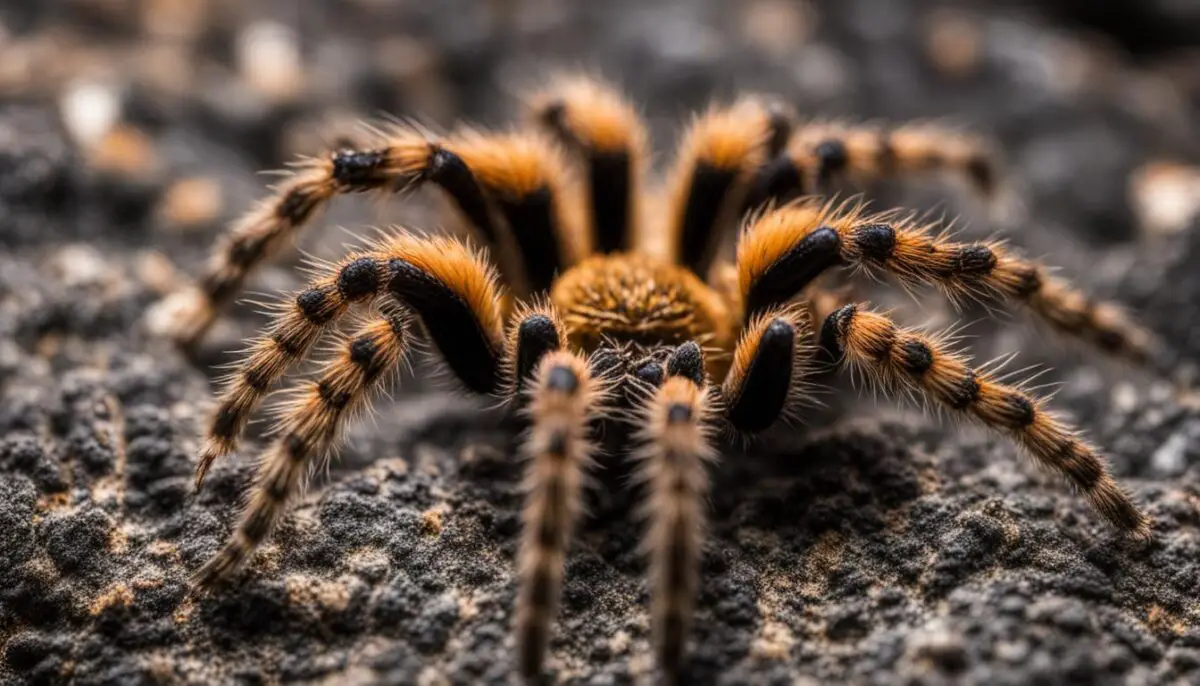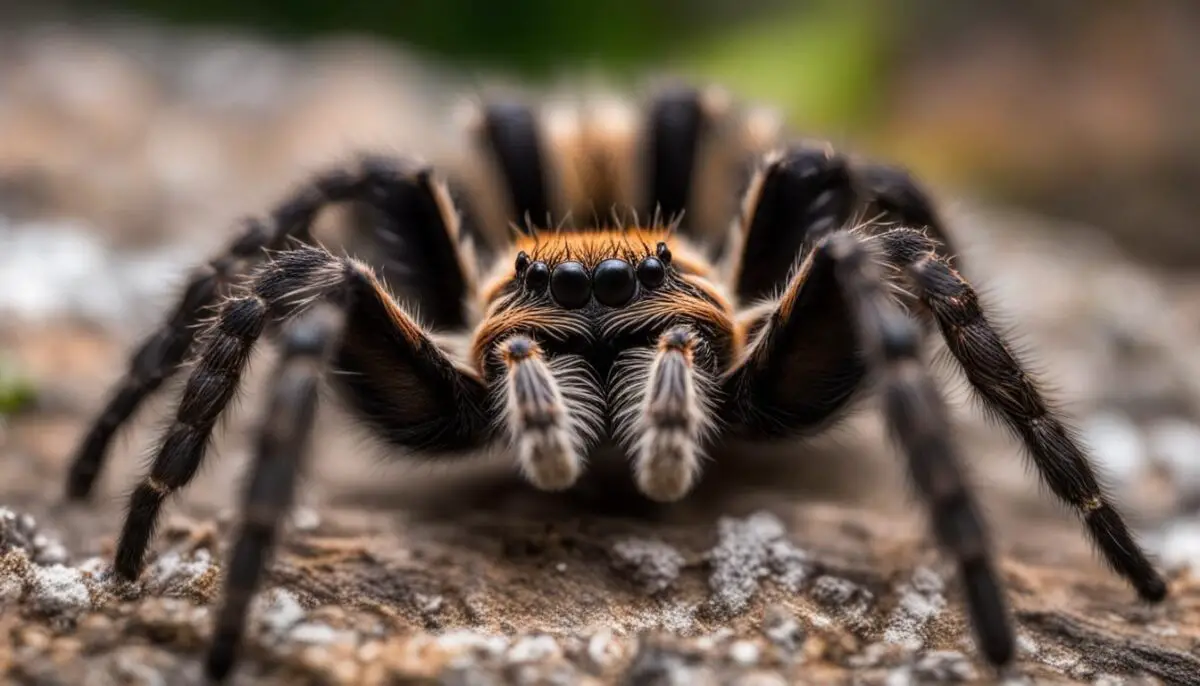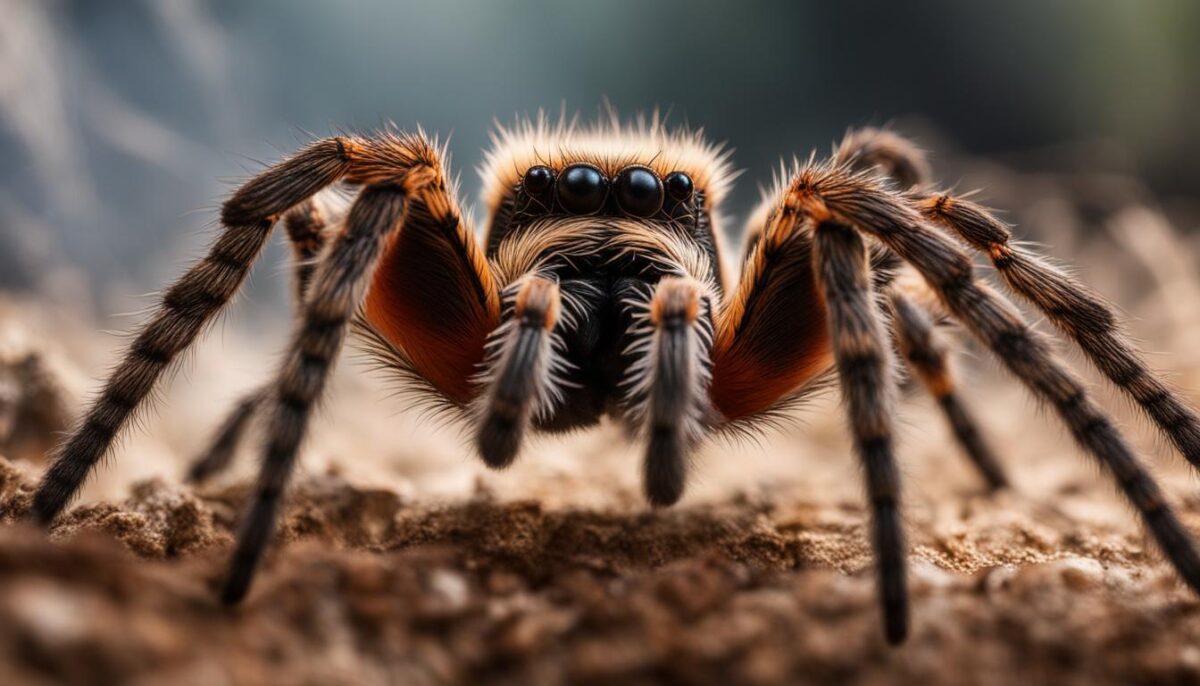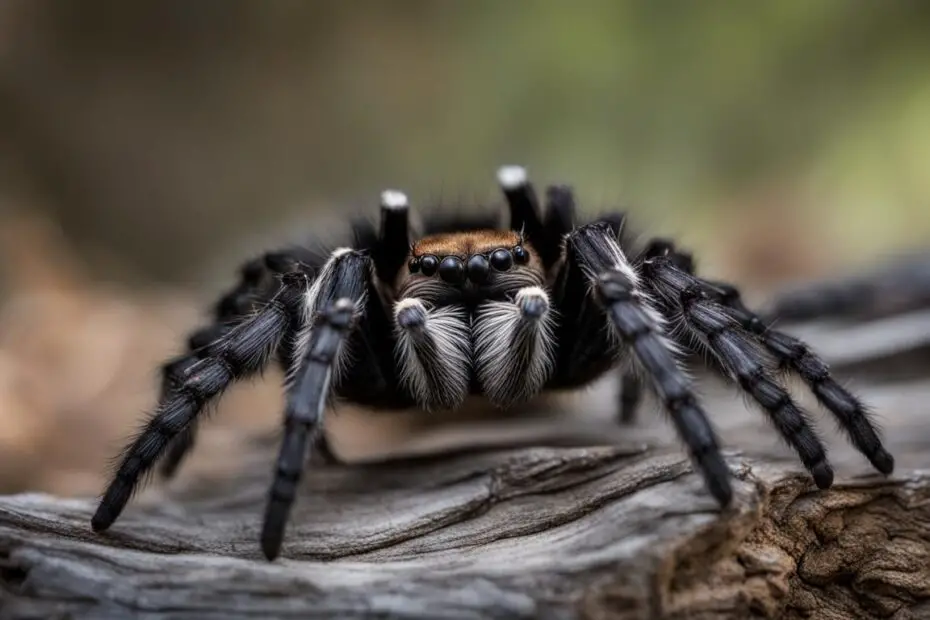Urticating hairs, or urticating setae, are a unique defense mechanism found in many tarantula species. These specialized hairs, located on the abdomens of tarantulas, serve as their first line of defense against predators or threats. While not all tarantulas possess urticating hairs, they are prevalent in about 90% of new world species. With seven different types of urticating hairs, tarantulas have evolved sophisticated mechanisms to protect themselves and their offspring. Let’s explore the fascinating world of tarantulas and their urticating hairs.
Key Takeaways:
- Tarantulas have urticating hairs as a defense mechanism.
- About 90% of new world tarantula species possess urticating hairs.
- There are seven different types of urticating hairs in tarantulas.
- Urticating hairs are used to ward off predators or threats.
- Tarantulas rely on urticating hairs as their first line of defense before resorting to biting.
What Tarantulas Have Urticating Hairs
Understanding Urticating Hair Types in Tarantulas
When it comes to defense mechanisms, tarantulas have developed a unique strategy – urticating hairs. These specialized hairs are found on the abdomens of many tarantula species and serve as a first line of defense against predators. Urticating hairs are prevalent in about 90% of new world tarantulas and come in seven different types, each with its own characteristics and potency. what tarantulas have urticating hairs
Type I hairs, measuring 0.2-0.6mm in length, are embedded with a penetrating tip and can be found in subfamilies Aviculariinae and Theraphosinae, excluding certain species like Grammostola. Type II hairs, ranging from 0.5-1.5mm in length, also have a penetrating tip and are primarily found in Aviculariinae species such as Avicularia, Pachistopelma, and Iridopelma.
Among the different types, type III hairs stand out as the most efficient against both vertebrates and invertebrates. These hairs are 0.3-1.8mm long and highly irritating to mammals. On the other hand, type IV hairs, measuring 0.06-0.2mm in length, are primarily found in Grammostola species and are also irritating to mammals.
In addition to these types, tarantulas have type V hairs, which are short and light and are embedded in hair follicles. These hairs are found in Ephebopus spiders. Type VI hairs are also embedded in hair follicles and exclusive to Hemirrhagus spiders. Lastly, type VII hairs have small barbs near the tip and belong to the Kankuamo genus.
Understanding the different types of urticating hairs in tarantulas provides valuable insights into their defense mechanisms and evolutionary adaptations. Each type serves a specific purpose and may target different enemies. Tarantulas rely on these hairs as their primary defense before resorting to biting, making them an essential aspect of their survival in the wild.
Understanding Urticating Hair Types in Tarantulas
The Importance of Urticating Hairs for Tarantulas’ Defense
Tarantulas have developed a unique defense mechanism known as urticating hairs, which play a crucial role in their protection against predators. When threatened, tarantulas will deliberately rub their hind legs against their abdomen, releasing a cloud of these specialized hairs. This defense mechanism serves as their first line of defense before resorting to biting. The urticating hairs can cause mechanical and chemical harm to the skin and mucous membranes of predators, potentially embedding themselves in the skin or eyes, resulting in irritation and discomfort. types of tarantulas with urticating hairs
The effectiveness of urticating hairs varies depending on the type. Type III hairs, for example, are particularly potent and highly irritating to both vertebrates and invertebrates. Different species of tarantulas possess different types of urticating hairs, each tailored to target specific enemies. The widespread presence of urticating hairs in tarantulas highlights their importance as a defense mechanism and showcases the adaptability of these fascinating creatures.
It is important for individuals to exercise caution when handling tarantulas that possess urticating hairs. These hairs can cause painful and potentially harmful effects in humans. Therefore, it is recommended to avoid direct contact with the urticating hairs and to handle tarantulas with care to minimize the risk of irritation. By respecting the tarantulas’ defense mechanisms and taking necessary precautions, we can coexist with these incredible creatures while ensuring our own safety.

Tarantula Defense Mechanism: The Use of Urticating Hairs
“When threatened, tarantulas will turn towards the attacker and rub their hind legs against their abdomen, releasing a cloud of urticating hairs.”
Urticating hairs can cause mechanical and chemical harm to the skin and mucous membranes of predators.
Different types of urticating hairs target different enemies, with type III urticating hairs being the most effective against both vertebrates and invertebrates. Tarantulas rely on these hairs as their primary defense before resorting to biting. It is important to handle tarantulas with urticating hairs with caution to avoid any unintended contact with these defensive structures and ensure our own safety. tarantula defense mechanism
| Type of Urticating Hair | Length | Main Characteristics | Target |
|---|---|---|---|
| Type I | 0.2-0.6mm | Penetrating tip | Aviculariinae, Theraphosinae (excluding some species) |
| Type II | 0.5-1.5mm | Penetrating tip | Aviculariinae (Avicularia, Pachistopelma, Iridopelma) |
| Type III | 0.3-1.8mm | Highly irritating to mammals | Effective against vertebrates and invertebrates |
| Type IV | 0.06-0.2mm | Irritating to mammals | Primarily found in Grammostola species |
| Type V | Short and light | Embedded in hair follicles | Ephebopus spiders |
| Type VI | Embedded in hair follicles | Exclusive to Hemirrhagus spiders | Exclusive to Hemirrhagus spiders |
| Type VII | Small barbs near the tip | Kankuamo genus | Kankuamo genus |
Tarantula Species with Urticating Hairs
Urticating hairs are not present in all tarantula species, but they are prevalent in approximately 90% of new world tarantulas. These specialized hairs serve as a crucial defense mechanism for these arachnids. Let’s take a look at some tarantula species that possess urticating hairs:
- Avicularia: Commonly known as the pink toe tarantula, Avicularia species are well-known for their urticating hairs.
- Pachistopelma: This genus of tarantulas, native to South America, also possesses urticating hairs.
- Iridopelma: Some species within the Iridopelma genus have urticating hairs as a defense mechanism.
- Grammostola: These tarantulas, including the famous rose hair tarantula, exhibit urticating hairs.
- Lasiodora: Known as the Brazilian salmon pink tarantula, Lasiodora species possess urticating hairs.
These are just a few examples of tarantula species that have urticating hairs. It’s important to note that not all tarantulas within these genera exhibit the same types of urticating hairs, and the potency of the hairs may vary between species.
Understanding the presence of urticating hairs in different tarantula species helps us appreciate the diversity and adaptability of these fascinating creatures. These hairs play a vital role in their defense mechanisms, allowing them to protect themselves and their offspring from potential threats. tarantula hair defense
| Tarantula Species | Urticating Hair Types |
|---|---|
| Avicularia | Type I, Type II |
| Pachistopelma | Type I, Type II |
| Iridopelma | Type I, Type II |
| Grammostola | Type I, Type IV |
| Lasiodora | Type I, Type III |
This table provides an overview of some tarantula species and the types of urticating hairs they possess. It’s interesting to see the variation in hair types among different species and how they contribute to each tarantula’s defense strategy.
Tarantulas’ Use of Urticating Hairs Beyond Defense
Tarantulas’ use of urticating hairs goes beyond their defense against predators. These specialized hairs also serve a crucial function in protecting their molting mats and cocoons with fertilized eggs. By strategically placing urticating hairs on these structures, tarantulas create an extra layer of defense to safeguard their vulnerable offspring and the molting process. This behavior showcases the remarkable intelligence and adaptability of these fascinating arachnids. urticating hairs in spider species
Tarantulas exhibit a remarkable understanding of their environment and the need to provide additional protection for their eggs and molting process. Urticating hairs act as a physical barrier to deter potential threats and predators from coming into contact with these sensitive areas. By releasing these hairs onto their molting mats and cocoons, tarantulas ensure the safety and survival of their offspring.
“The use of urticating hairs beyond defense demonstrates the sophisticated strategies and behaviors exhibited by tarantulas to protect their vulnerable stages.”
It is essential to exercise caution when working inside the cage of a tarantula with urticating hairs to avoid any unintended contact with these defensive structures. The effects of urticating hairs can be painful and potentially harmful to humans, causing skin irritation and discomfort. Understanding the multifaceted use of urticating hairs allows us to appreciate the intricacies and adaptability of tarantulas and their unique defense mechanisms. how tarantulas use urticating hairs
Safety Tips for Handling Tarantulas with Urticating Hairs
Handling tarantulas with urticating hairs requires caution and awareness to ensure the safety of both the handler and the spider. Here are some important safety tips to keep in mind: tarantula safety tips.
- Wear protective gear: When handling tarantulas with urticating hairs, it is advisable to wear protective clothing such as long sleeves, gloves, and goggles. This will help minimize direct contact with the urticating hairs and reduce the risk of irritation or injury.
- Avoid direct contact with the abdomen: Urticating hairs are primarily located on the tarantula’s abdomen, so it is crucial to avoid touching or disturbing this area. Instead, focus on gently handling the tarantula from the sides or back, using proper handling techniques recommended by experts.
- Handle with care and confidence: Tarantulas are delicate creatures, and they can sense fear or uneasiness. It is important to handle them with confidence and avoid sudden movements that may startle or agitate them. Slow and steady movements will help create a calm and secure environment for both the handler and the tarantula.
- Wash hands thoroughly afterwards: After handling a tarantula with urticating hairs, it is essential to wash your hands thoroughly with soap and water. This will help remove any stray urticating hairs that may have come into contact with your skin, reducing the potential for irritation or discomfort.
By following these safety tips, handlers can minimize the risks associated with handling tarantulas with urticating hairs while ensuring a positive and safe interaction with these fascinating arachnids.

| Common Mistakes to Avoid | Tips for Safe Handling |
|---|---|
| 1. Touching the tarantula’s abdomen directly | 1. Handle the tarantula from the sides or back |
| 2. Not wearing protective gear | 2. Wear long sleeves, gloves, and goggles |
| 3. Making sudden movements or startling the tarantula | 3. Handle the tarantula with confidence and slow movements |
| 4. Neglecting to wash hands after handling | 4. Thoroughly wash hands with soap and water |
The Morphology and Classification of Urticating Hairs
Understanding the morphology and classification of urticating hairs in tarantulas is essential to grasp the diversity and evolution of this unique defense mechanism. With seven different types of urticating hairs, each with its own characteristics and distribution among tarantula species, these hairs play a crucial role in tarantulas’ survival strategies.
The classification of urticating hairs serves as a taxonomic tool for the classification of New World theraphosid spiders. Each hair type varies in size, shape, and the presence of barbs along the shaft, making them specialized for specific targets and levels of effectiveness against different predators. From the small, penetrating type I hairs to the highly irritating type III hairs, tarantulas have developed an impressive array of defense mechanisms.
To provide a visual reference, here is a table summarizing the different types of tarantulas with their corresponding urticating hair types:
| Tarantula Species | Urticating Hair Types |
|---|---|
| Avicularia | Type II |
| Pachistopelma | Type II |
| Iridopelma | Type II |
| Grammostola | Type IV |
| Lasiodora | Type III |
| Acanthoscurria | Type III |
Understanding the morphology and classification of urticating hairs not only provides insights into tarantulas’ defense mechanisms but also sheds light on the complexity and adaptability of these fascinating arachnids.

Lepidopteran caterpillars, the larval stage of butterflies and moths, also employ urticating hairs as a defense mechanism. These hairs can cause irritation and, in some cases, may contain venom-producing cells, making them more dangerous for larger animals or humans. It’s crucial to exercise caution when coming into contact with caterpillars to avoid any potential harm or discomfort. Appreciating the beauty of nature is important, but it’s equally important to respect the self-defense mechanisms of different organisms.
By understanding the presence of urticating hairs in a variety of species, including tarantulas, plants, and caterpillars, we gain a deeper appreciation for the remarkable adaptations that have evolved to ensure survival. These hairs serve as a reminder of the intricate connections between different organisms in the natural world and highlight the importance of respecting and coexisting harmoniously with diverse species.
Conclusion
Tarantulas and their urticating hairs are a remarkable example of nature’s defense mechanisms. These specialized hairs, found in about 90% of new world tarantulas, serve as the first line of defense against predators. There are seven different types of urticating hairs, each with its own characteristics and potency.
By rubbing their hind legs against their abdomens, tarantulas release a cloud of urticating hairs, causing irritation and discomfort to predators. These hairs can embed themselves in the skin or eyes, providing a powerful deterrent. Additionally, tarantulas use urticating hairs to protect their vulnerable molting mats and cocoons with fertilized eggs.
Understanding the role and diversity of urticating hairs in tarantulas provides insight into the complex world of these fascinating arachnids. It is essential to exercise caution when handling tarantulas with urticating hairs to ensure personal safety and minimize potential irritation. By respecting and appreciating the unique defense mechanisms of tarantulas, we can coexist with these incredible creatures in harmony.
FAQ
What are urticating hairs?
Urticating hairs, or urticating setae, are a defense mechanism found in many tarantula species. These hairs are located on the abdomens of tarantulas and are used to ward off predators or threats.
How many types of urticating hairs are there?
There are seven different types of urticating hairs found in tarantulas, each with its own characteristics and potency.
Which tarantulas possess urticating hairs?
Urticating hairs are prevalent in about 90% of new world tarantulas. Some examples of tarantula species with urticating hairs include Avicularia, Pachistopelma, Iridopelma, Grammostola, Lasiodora, Acanthoscurria, Nhandu, Megaphobema, Sericopelma, Eupalaestrus, Proshapalopus, Brachypelma, Cyrtopholis, and more.
How do tarantulas use urticating hairs for defense?
When threatened, tarantulas will rub their hind legs against their abdomen, releasing a cloud of urticating hairs. These hairs can cause mechanical and chemical harm to the skin and mucous membranes of predators.
Are urticating hairs harmful to humans?
Yes, urticating hairs can cause physical irritation and discomfort if they come into contact with human skin or eyes. It is recommended to use caution when handling or working with tarantulas that possess urticating hairs.
Do all tarantulas have urticating hairs?
No, not all tarantula species possess urticating hairs. They are prevalent in about 90% of new world tarantulas.
How can I minimize potential irritation when handling tarantulas with urticating hairs?
It is important to take precautions when handling tarantulas with urticating hairs, such as wearing protective gloves and avoiding direct contact with the hairs. It is also recommended to wash your hands thoroughly after handling tarantulas.
Are urticating hairs found only in tarantulas?
No, urticating hairs are also found in various plants and lepidopteran caterpillars as a defense mechanism against predation.
What is the importance of studying the morphology and classification of urticating hairs?
The classification and study of urticating hairs serve as taxonomic tools for the classification of New World theraphosid spiders.


I do like the manner in which you have presented this specific concern plus it really does give me a lot of fodder for thought. Nevertheless, coming from what precisely I have experienced, I just trust as other commentary pack on that folks remain on issue and in no way embark upon a tirade involving some other news du jour. All the same, thank you for this fantastic piece and though I can not necessarily concur with it in totality, I regard your point of view.
Hi there, just became alert to your blog through
Google, and found that it is really informative.
I’m going to watch out for brussels. I’ll appreciate if you continue this in future.
A lot of people will be benefited from your writing. Cheers!
Escape rooms hub